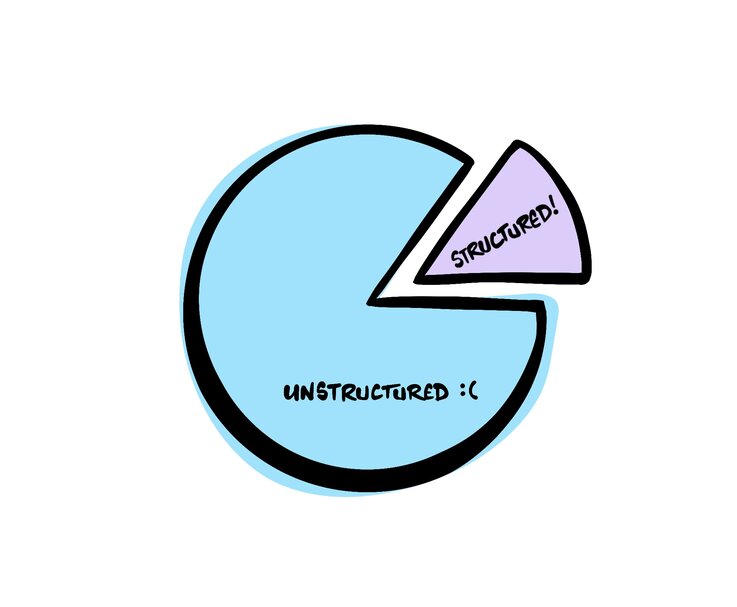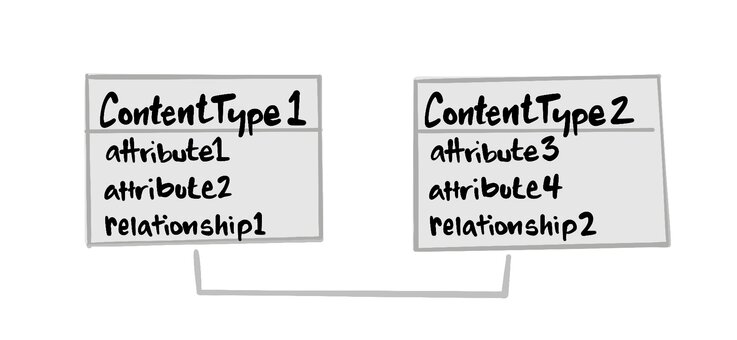



Structured Data: What It Is and Why You Need It
Last updated: July 15, 2024
Introduction to structured data
Structured data is incredibly helpful for organizations looking to make the most of their data. It's all about organizing and standardizing your data to make it easier to access, update, and analyze.
Think of it like a well-organized closet. When everything has its place, finding what you need and putting things back where they belong is a breeze. The same goes for your data. When it's structured, you can quickly retrieve the information you need and make updates while saving time.
Benefits of structured data for content management
Structured data is a powerhouse when it comes to content management. Here are just a few of the benefits:
- Updating and reusing content across multiple platforms more easily
- Improving search engine optimization (SEO)
- Facilitating omnichannel experiences
- Increasing sustainability and efficiency

By structuring your data, you're setting yourself up for success. You'll be able to make better decisions faster and with less effort.
Understanding unstructured data
On the flip side, we have unstructured data. This is data that lacks a predefined data model or organization. Think qualitative data, images, videos, and text files.
While unstructured data can be valuable, it has its fair share of challenges. It isn't easy to analyze and requires specialized tools and expertise to make sense of it all. In contrast, semi-structured data, which does not conform to a strict data model but has some organizational properties, is increasingly important in the industry.
Challenges of working with unstructured data
Here's the kicker: it's estimated that 80-90% of data is unstructured. That's a huge chunk of data that organizations are struggling to use.
Working with unstructured data is not easy. It takes time, resources, and know-how to extract valuable insights from the chaos.

The power of structured content
Enter structured content. This content is planned, developed, and connected outside an interface, making it ready for any interface. Structured content enables publishers to create content connected to any outlet owned by anyone through APIs and web services.
Structured content improves SEO, increases sustainability and efficiency in content creation, and enables personalized, dynamic content.
How structured content improves SEO and digital experiences
When your content is structured, search engines can easily understand and interpret it. This leads to better search engine rankings and more traffic to your site.
But it's not just about SEO. Structured content also enables personalized, dynamic content experiences. You can serve the right content to the right person at the right time, making for a better user experience..

Creating a data model
So, how do you get started with structured content? It all begins with content modeling. A relational database can help store structured content, making it easier to manage and update across multiple pages and platforms. This is the process of defining the types of content you need, their attributes, and relationships.
Think of it like a blueprint for your content. It provides a roadmap for content creation and management, ensuring everyone is on the same page.

Ways to model content for better insights
There's no one-size-fits-all approach to content modeling. It all depends on your organization's needs and goals.
One way to do this is to create a data model that documents the types of content and their relationships. This enables better content management in the future.

Implementing structured content in a content management system (CMS)
A content management system (CMS) is a powerful tool for enabling structured content. It provides a structured framework for content creation and management, making it easy for content teams to focus on creating new content rather than recreating existing content. A CMS can also integrate with a data warehouse, serving as a central repository for enterprise data and supporting large-scale data analysis for businesses.

Best practices for CMS implementation
Implementing a CMS is no small feat. It takes a systemic approach to build a robust structured content management system.
Some best practices to keep in mind:
- Keep content up-to-date and eliminate duplicative and deprecated content.
- Use a structured approach to content creation and management.
- Involve all stakeholders in the process, from content creators to developers to business leaders.
Applications of structured content
One of the most exciting applications of structured content is headless CMS implementation and omnichannel publishing.
With a headless CMS, your content is decoupled from the presentation layer. This means you can have content repositories that any channel can pull from, whether it's a website, mobile app, or even a smart speaker. This approach promotes efficiency and sustainability by allowing the reuse of the same content across different platforms and channels.

Screenless interfaces and personalization
Structured content is also essential for screenless interfaces and personalization. When your content is structured, computers can easily interpret and connect it, providing better digital experiences for your users.
Imagine a world where your content can be easily adapted for voice assistants, chatbots, and other emerging technologies. That's the power of structured content.

Structured content best practices
Of course, structured content is only as good as the processes you have to manage it. Here are a few best practices to keep in mind:
- Eliminate duplicative and deprecated content.
- Keep content up-to-date and relevant.
- Remove old content that is no longer used.
Breaking down monolithic content and letting it be flexible
Another best practice is to break down your content into smaller components. This makes it more flexible and easier to reuse across different channels and platforms. By doing so, you can move beyond the limitations of single web pages and think about how your content can be used in various contexts.
You can also add meta-data to your content for faster discovery and easier usage. And don’t forget to use language that targets different demographics to ensure your content resonates with your audience.

When structured content Is useful (and when it's not)
Structured content shines when you have a large amount of content that needs to be easily searchable, reusable, and adaptable to different platforms. It's beneficial for complex content ecosystems and when you need to deliver content across multiple channels.
However, it can be resource-intensive to implement and maintain. For smaller, simpler content ecosystems or when you need to prioritize quick implementation, traditional unstructured approaches might be more suitable.
The power of structured UI
Structured UI applies the principles of structured content to visual and interactive elements. It creates a system of modular, reusable UI components that can be easily managed and updated.
Benefits include:
- Improved consistency across digital properties
- Faster development and iteration cycles
- Easier maintenance and updates
- Better collaboration between team members

Implementing structured UI
A structured UI system provides a framework for creating and managing user interfaces flexibly and consistently. It typically includes a library of pre-built components that can be easily combined and customized.
Platforms like Builder.io offer tools that allow teams to create and manage structured UI components visually, enabling content creators and marketers to have more control over content presentation while adhering to design guidelines.
Best practices for implementation include:
- Conduct a component audit
- Create a design system
- Build a reusable component library
- Use a visual editing and component management platform
- Train your team on the new system
Applications of structured UI
Headless implementation and omnichannel publishing
Structured UI works well with headless architecture, allowing for truly flexible digital experiences across different channels and platforms.
AI-driven UI generation and personalization
With a well-structured system of UI components, it becomes possible to use AI to generate and optimize user interfaces automatically, opening up new possibilities for personalization and rapid iteration.
When to choose structured UI
Consider implementing structured UI when:
- You have a complex, multi-channel digital ecosystem
- You need frequent UI updates or iterations
- You want to empower non-technical team members to make UI changes
- You’re planning to implement AI-driven UI optimization
Traditional approaches might suffice for simple websites or applications with infrequent changes.

Understanding the benefits and limitations of structured UI can help you decide whether this approach is right for your organization. Builder.io offers efficient ways to implement structured UI systems, but always consider your specific needs and resources when making this decision.
Overcoming challenges and achieving sustainability
Starting small and using business language
Of course, implementing structured content isn't without its challenges. One of the biggest obstacles is getting buy-in from stakeholders.
The key is to start small and use business language to communicate the benefits of structured content. Show how it can improve efficiency, drive revenue, and provide better user experiences.
Common obstacles and how to overcome them
Other common obstacles include a need for more resources and expertise. However, these can be overcome by starting small, using business language, and demonstrating the benefits of structured content.
It's also important to involve all stakeholders, from content creators to developers to business leaders. You can create a sustainable structured content strategy that drives results by working together.
Getting started with structured data
Ready to start harnessing the power of structured data? Here are some steps to get you started:
- Audit Your Content: Look at your content types and identify common elements and structures.
- Create Models: Based on your audit, create data models defining each content type's structure.
- Migrate Your Content: Move your existing content into the new structured format. This can be a big job, but the long-term benefits are worth it.
- Train Your Team: Make sure everyone understands the new structure and how to work with it.
- Iterate and Improve: As you use your new structured data, you'll likely find ways to improve your models. Don't be afraid to make changes as needed.
Structured data might seem complex at first, but it's a powerful tool that can transform how you work with content. By investing in a good structure now, you're setting yourself up for more efficient, effective content management.
Builder's Visual Development Platform is revolutionizing front-end programming, offering AI-powered design-to-code, a Visual Editor, and an enterprise CMS. By tackling the industry's hardest problems, we're changing how digital experiences are built, enabling teams to create, iterate, and optimize with unmatched speed and quality.
Frequently asked questions (FAQ)
What is structured data?
Structured data is organized and stored in a predefined format, making it easier to search, analyze, and use across different platforms and devices. Examples of structured data include data stored in databases or spreadsheets.
What is the difference between structured data and unstructured data?
Structured data has a predefined format and is organized to make it easy to search and analyze. Unstructured data, on the other hand, does not have a predefined format and is more challenging to search and explore. Examples of unstructured data include text documents, images, and videos.


